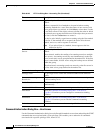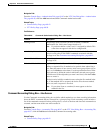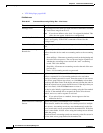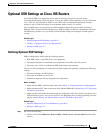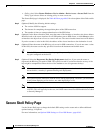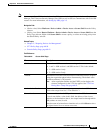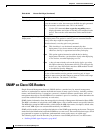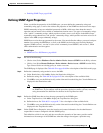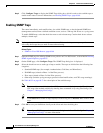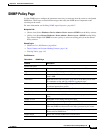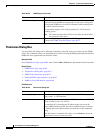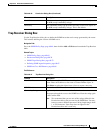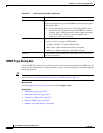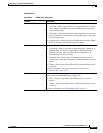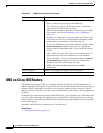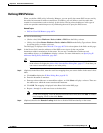
60-68
User Guide for Cisco Security Manager 4.4
OL-28826-01
Chapter 60 Router Device Administration
SNMP on Cisco IOS Routers
Step 5 Click Configure Traps to display the SNMP Traps dialog box, which is used to select which traps to
enable on the router. For more information, see Enabling SNMP Traps, page 60-68.
Enabling SNMP Traps
The router immediately sends notifications, also called SNMP traps, to the designated SNMP host
(management station) when a defined condition occurs, such as a link up, link down, or a syslog event.
To enable SNMP traps, select the check box next to each relevant trap. Certain check boxes activate
multiple, related traps.
Note Each trap that you enable consumes system resources. To lessen the impact on system performance,
select only those traps that you need for network monitoring.
Related Topics
• SNMP on Cisco IOS Routers, page 60-66
Step 1 Open the SNMP page for defining SNMP server policies on Cisco IOS routers, as described in Defining
SNMP Agent Properties, page 60-67.
Step 2 On the SNMP page, click Configure Traps. The SNMP Traps dialog box is displayed.
Step 3 Select the check box next to each type of trap to enable. The traps are divided into the following four
categories:
• Standard SNMP traps (for example, Authentication, Cold Start, and Warm Start).
• ISAKMP traps (related to Phase 1 of the IPsec process).
• IPsec traps (related to Phase 2 of the IPsec process).
• Other traps (includes syslog messages, protocol-related notifications, and CPU usage warnings).
See Table 60-32 on page 60-73 for a description of the available traps.
Note You must add command-line interface (CLI) commands to fully implement the IP multicast and
CPU traps. One method available for entering these commands is by using FlexConfigs. See
Chapter 7, “Managing FlexConfigs”.
Tip Click Select All to enable all traps displayed in the dialog box or Deselect All to disable all the
traps.
Step 4 Click OK to save your definitions locally on the client and close the dialog box.
Tip To configure SNMP traps not included in this dialog box, define a FlexConfig. See Chapter 7,
“Managing FlexConfigs” for more information.



